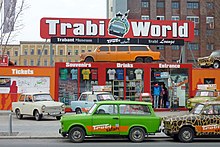In mid-1989, thousands of East Germans began loading their Trabants with as much as they could carry and drove to Hungary or Czechoslovakia en route to West Germany–the so-called "Trabi Trail". Many had to get special permission to drive their Trabants into West Germany. The cars did not meet West German emissions standards and polluted the air at four times the European average.[23]
A licensed version of the Volkswagen Polo engine replaced the Trabant's two-stroke engine, the result of a trade agreement between East and West Germany. The first prototypes were built in 1988, with pre-series cars appearing in 1989, but series production only began in May 1990 - By which time the two German states had already agreed to reunification. The locally built EA111-series engine was given the model code BM 820 by the East Germans; the plant also made 1.3-liter versions for the Wartburg 1.3 (BM 860) and the Barkas utility vehicle (BM 880).[24] The model, the Trabant 1.1, also had minor improvements to its brake and signal lights, a renovated grille, and MacPherson struts instead of a leaf-spring-suspended chassis.
By April 1991, after only eleven months, the Trabant 1.1 was discontinued. In total, 3.7 million Trabant vehicles had been produced.[25] However, it soon became apparent that there was no place for the Trabant in a reunified German economy. Its inefficient, labour-intensive production line had only survived thanks to government subsidies.
The Zwickau factory in Mosel (where the Trabant was manufactured) was sold to Volkswagen AG; the rest of the company became HQM Sachsenring GmbH. Volkswagen redeveloped the Zwickau factory into a centre for engine production; it also produces some Volkswagen Golfs and Passats.
1990s and later
According to Richard Leiby, the Trabant had become "a symbol of the technological and social backwardness of the East German state."[26] Trabants became a symbol of the GDR's serious flaws in the West after the fall of the Berlin Wall, when many were abandoned by their Eastern owners who migrated west. Unlike the Lada Niva, Škoda Estelle, Polski Fiat (design licensed from the Italian car manufacturer) and Yugo, the Trabant had negligible sales in Western Europe.
A Trabant could be bought for as little as a few Deutsche Marks during the early 1990s, and many were given away. Although prices recovered as they became collectors' items, they remain inexpensive cars. In her Bodywork project, performance artist Liz Cohen transformed a 1987 Trabant into a 1973 Chevrolet El Camino.[27] The Trabant was planned to return to production in Uzbekistan as the Olimp during the late 1990s,[28] but only one model was produced.[29]
Former Bulgarian Foreign Minister and Atlantic Club of Bulgaria founding president Solomon Passy owned a Trabant which was blessed by Pope John Paul II in 2002 and in which he took NATO Secretaries General Manfred Wörner, George Robertson, and Jaap de Hoop Scheffer for rides. In 2005, Passy donated the vehicle (which had become symbolic of Bulgaria's NATO accession) to the National Historical Museum of Bulgaria.[30] In 1997, the Trabant was celebrated for passing the moose test without rolling over, as the Mercedes-Benz W168 had; a Thuringian newspaper's headline read, "Come and get us, moose! Trabi passes A-Class killer test".[31]
The Trabant entered the world of diplomacy in 2007 when Steven Fisher, deputy head of mission at the British Embassy in Budapest, used a 1.1 (painted as close to British racing green as possible) as his diplomatic car.[32][33] American Trabant owners celebrate the fall of the Berlin Wall with the Parade of Trabants, an annual early-November rally held in Washington, D.C. The event, sponsored by the privately owned International Spy Museum, includes street tours in Trabants, rides, live German music and displays about East Germany.[34]







No comments:
Post a Comment